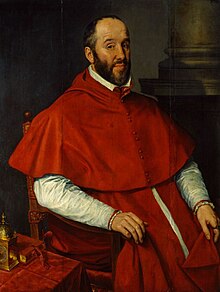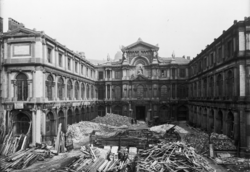Antoine Perrenot de Granvelle

Antoine Perrenot de Granvelle also Granvella (born August 20, 1517 in Ornans near Besançon ; † September 21, 1586 in Vallecas near Madrid ), eldest son of Nicolas Perrenot de Granvelle , was a cardinal and played an important role as a minister in the Spanish Netherlands . He was also an important art collector .
Life
Antoine Perrenot studied law in Padua under the famous Pietro Bembo , then theology in Leuven, and was introduced to political circles by his father. Shortly after his 23rd birthday he was named by Pope Paul III. appointed Bishop of Arras , he was ordained priest in 1540 and on May 21, 1543 by Cardinal Juan Tavera , Archbishop of Toledo , he was ordained episcopal . Rarely present in Arras, he had his diocese administered by titular bishops , initially by Paschasius Maupair OP and from 1556 by François Richardot .
He attended the Diets in Worms and Regensburg , gave a speech at the opening of the Tridentine Council and, under the direction of his father, served the emperor as negotiator on many occasions from 1545 to 1550. In doing so, he acquired business fluency and knowledge of European politics, which made him the Emperor's State Secretary in 1550, succeeding his father. As such, however, he had neither the luck nor the security, let alone the tact of his father in difficult situations. When the reign of Charles V passed to Philip II , Antoine Perrenot remained on the State Council of the Spanish King, but was no longer the actual leading head of Spanish politics.
He led the negotiations between Spain and France that led to the Peace of Cateau-Cambrésis in 1559 . In the same year he joined the governor of the Netherlands , Margaret of Parma , as a minister and was appointed Archbishop of Mechelen by the king in 1560 . Confirmed by Pope Pius IV on March 10, 1561, he was previously elevated to cardinal status by the Pope in the consistory of February 26, 1561 and installed as cardinal priest of San Bartolomeo all'Isola in July of the same year . In the following years he changed his Roman title churches more often and received an additional 1562-1565 San Silvestro in Capite in commendam . In 1570 he held the title of Sant'Anastasia for a short time , only to change to San Pietro in Vincoli in June . In 1578 he received briefly Santa Maria in Trastevere , before he was from Gregory XIII. in October of the same year was promoted to Cardinal Bishop of Sabina . Granvelle had his archdiocese of Mechelen administered by vicars general and auxiliary bishops.
As a stranger, however, he soon became the object of the hatred of the Dutch, who accused him of all strict measures, while Philip was suspected of having promoted the progress of the new teaching. The growing opposition of the Dutch against Granvelle and a personal resentment of the governor Margarete induced the king to recall him from the Netherlands in 1564.
Granvelle went to Besançon and there maintained contact with scholars and artists. In 1565 Philip sent him to Rome to represent the interests of Spain in the College of Cardinals and in the immediate vicinity of the Pope. From Rome, Granvelle went to Naples as viceroy from 1571 to 1575 and, after another stay in Rome, where he also took part in the conclave of 1572 (election of Gregory XIII ), was appointed President of the Supreme Council of Italy and moved to Madrid in 1579 appointed the Council of State. He negotiated the unification of Portugal with Spain (1580) and arranged for the connection between the Infanta Catherine and the Duke of Savoy (1584).
After his resignation as Archbishop of Mechelen Granvelle was elected Archbishop of Besançon in 1584 and was supported by Pope Gregory XIII. confirmed and awarded the Pallium . The administration of the diocese was taken over by his relatives Jacues de Saint-Maurice, Prior of Bellefontaine, and François de Grammont.
After his death on September 21, 1586 and the funeral ceremonies in Madrid, his body was transferred to Besançon and buried in the Cathédrale Saint-Jean . His palace in Brussels, where he lived from 1555 to 1564, was demolished in 1931. Today the Galerie Ravenstein shopping center is located there.
An important collection of manuscripts and prints belonged to his estate. His letters and memoirs are in the Besançon archives.
- Prosper Levesque communicated this in Mémoires pour servir à l'histoire du cardinal Granvelle (Paris 1753);
- most of it is published by Charles Weiss: Papiers d'État du cardinal de Granvelle (Paris 1842–61, 9 vols.);
- Edmond Poullet and Charles Piot published a sequel ( Correspondance du cardinal Granvelle 1565–86 , Brussels 1878–84, Vol. 1–4).
Of his brothers, the elder, Thomas Perrenot de Granvelle , was comte de Cante-Croix (* 1521), Spanish ambassador to Paris and Vienna and died in 1571; the other, Friedrich Perrenot de Champagne (* 1536), became governor of Antwerp in 1571 and imprisoned from 1578–84 for aiding the Dutch uprising and died in 1600.
literature
sorted alphabetically by author
- Claudia Banz : Courtly patronage in Brussels. Cardinal Antoine Perrenot de Granvelle (1517–1586) and the Archdukes Albrecht (1559–1621) and Isabella (1566–1633) (= Berlin writings on art. Vol. 12). Gebr. Mann, Berlin 2000, ISBN 3-7861-2309-8 (also: Berlin, Free University, dissertation, 1996).
- Friedrich Wilhelm Bautz : Antoine Perrenot de Granvelle. In: Biographisch-Bibliographisches Kirchenlexikon (BBKL). Volume 2, Bautz, Hamm 1990, ISBN 3-88309-032-8 , Sp. 286-287.
- Hans-Joachim Böttcher : Princess Anna of Saxony 1544–1577 - A life tragedy , Dresdner Buchverlag, Dresden 2013, ISBN 978-3-941757-39-4 . In the area: pp. 49–125.
- Nils Büttner : Pulchrum et utilitas. Understanding of nature and world experience in early modern times using the example of the "Granvella Gardens". In: Die Gartenkunst 14 (1/2002), pp. 26–34.
- Luc Courchetet d'Esnans : Histoire du cardinal de Granvelle, archevesque de Besançon, viceroi de Naples, ministre de l'empereur Charles-Quint, et de Philippe Second, roi d'Espagne. Duchesne, Paris 1761.
- Maurice van Durme: Antoon Perrenot, Bishop van Atracht, Kardinaal van Granvelle, Minister van Karel V en van Filips II (1517–1586) (= Negotiating van de Koninklijke Vlaamse Academie voor Wetenschappen, Letteren en Schone Kunsten van België. Class of letters. Vol. 15 = 18, ISSN 0770-1047 ). AWLSK, Brussels 1953 (Revised and expanded edition in Spanish translation: El Cardenal Granvela (1517–1586). Imperio y Revolución bajo Carlos V y Felipe II (= El Hombre y su Tiempo. Vol. 2, ZDB -ID 2454695-1 ) Edición revisada y ampliada por el autor. Teide, Barcelona 1957).
- Krista de Jonge, Maurice van Durme: Les Granvelle et les anciens Pays-Bas (= Symbolae Facultatis Litterarum Lovaniensis. Series B, Vol. 17). Universitaire Pers, Leuven 2000, ISBN 90-5867-049-X .
- Hélène Richard, Germaine Mathieu: La bibliothèque de Granvelle (= Re-découvertes. Vol. 2). Fédération française de coopération entre bibliothèques, Paris 1992, ISBN 2-907420-04-6 (exhibition catalog: Besançon, Bibliothèque d'étude et de conservation, 2 octobre – 12 decembre 1992).
Web links
- Literature by and about Antoine Perrenot de Granvelle in the catalog of the German National Library
- Perrenot de Granvelle, Antoine. In: Salvador Miranda : The Cardinals of the Holy Roman Church. ( Florida International University website), accessed October 23, 2016.
- Entry on Antoine Perrenot de Granvella on catholic-hierarchy.org ; accessed on October 23, 2016.
Individual evidence
- ^ Hugh Trevor-Roper: Princes and Artists. Patronage and Ideology at Four Habsburg Courts. 1517-1633. Thames & Hudson, London 1976, p. 112.
- ^ D. Tampere: Historic Buildings & Places That vanished in Brussels. on theculturetrip.com; accessed on February 21, 2018
| predecessor | Office | successor |
|---|---|---|
| Eustache de Croy |
Bishop of Arras 1538–1559 |
François Richardot |
| - |
Archbishop of Mechelen 1561–1582 |
Johannes Hauchin |
| Giovanni Antonio II Serbelloni |
Cardinal Bishop of Sabina 1578–1586 |
Inigo d'Avalos d'Aragona |
| Claude III de la Beaume |
Archbishop of Besançon 1584–1586 |
Ferdinand de Rye |
| personal data | |
|---|---|
| SURNAME | Granvelle, Antoine Perrenot de |
| ALTERNATIVE NAMES | Granvelle d. J. |
| BRIEF DESCRIPTION | French cardinal and minister |
| DATE OF BIRTH | August 20, 1517 |
| PLACE OF BIRTH | Ornans |
| DATE OF DEATH | September 21, 1586 |
| Place of death | Madrid |


